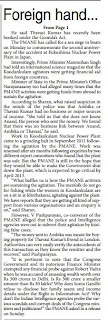Money laundering: Switzerland's envy. India's pride?
March 18, 2013 16:40 IST
M. R. Venkatesh
Several corporate, including some airlines, software and even consulting companies operate in India with dodgy secretive and multi-layered ownership patterns, writes M R Venkatesh.
The Mahabharata refers to the Pandavas and Kauravas as of Kuru clan. Simultaneously, they are also referred to as the Chandra vanshis - the descendents of Moon. How is that possible?
The story is adult material. Simply told, Tara, the wife of Brihaspati fell in love with Chandra (Moon) and eloped with him. A distraught Brihaspati (being the guru of Devas) refuses to perform the yagnas, so very vital for Devas to succeed. Expectedly Devas panic. After several rounds of deliberations Indra, the king of Devas, pragmatically orders Tara to return back to her husband.
But by then there was a significant development. Tara was pregnant. The question posed was - who was the father of this child? While both Chandra and Brihaspati claimed to be the father, Tara steadfastly refused to reveal the identity of the father of her child. Just as everyone was reconciled to this fact being a secret, suddenly, the child in Tara’s womb demanded to know who the father was.
Compelled by the demand of her child, Tara blurted out the truth that Chandra, not Brihaspathi, was the father. Now that the truth was known Brihaspati was reluctant to accept the step-child. And despite his valid objections, Indra decreed for the sake of expedience that it shall henceforth be Brihaspati’s child.
Expedience - and that is the operative word.
But this story of Tara and her child brings about the crucial distinction between an apparent legal owner and a factual beneficial owner - one of the several underlying themes that complete the narrative in this great Indian epic.
Fascinatingly, this concept of beneficial owner comes to dominate the modern world of finance too. The fundamental question posed in any financial transaction is - who is the ultimate beneficiary of any financial transaction? Should legal ownership dominate beneficial ownership? Should the identity of the beneficial owner be disclosed to the outside world?
Private bank or foreign bank?
Naturally, when media reports last week suggested that three private banks in India indulged in rampant money laundering, questions arose. Who are the promoters of these banks? Is the directing mind of these banks situated in India? Or is it abroad?
Needless to emphasise, these questions have been dominating the higher echelons of banking and finance in India for the past few years. Yet, there are no precise answers to these pointed questions.
For instance in the case of ICICI Bank [ Get Quote ], approximately 37 per cent of its shares are held by Foreign Institutional Institutions (FII) while another 29 per cent are held by custodians for depository receipts issued by the bank.
That makes it a whopping sixty-six per cent foreign holding in the aggregate. The shareholding pattern in case of HDFC Bank [ Get Quote ] and Axis Bank more or less mirrors that of ICICI Bank. That raises an important question - who are the beneficial owners of all these banks? Who exercises effective controls on these banks, especially as these are foreign investments?
Our presumption is that regulators across continents are tightly monitoring and supervising such cross-border investments. But experiences of the past decade or so suggest most of these investments originate from - read pass through - tax havens where regulation on disclosing ownership details and know-your-customer norms are weak if not totally non-existent.
It is not without reason the Prevention of Money Laundering Act (PMLA) was recently amended to define beneficial owner to mean “an individual who ultimately owns or controls a client of a reporting entity or the person on whose behalf a transaction is being conducted and includes a person who exercises ultimate effective control over a juridical person.” (clause (fa) of S 2 of PMLA)
The next time you visit these three banks ask for their beneficial owners under the PMLA. The answer is bound to raise eyebrows. But let me hasten to add that these three banks are not the sole exceptions in India. Several corporate, including some airlines, software and even consulting companies operate in India with dodgy secretive and multi-layered ownership patterns.
Yet all of them consistently talk of transparency, corporate governance and ethics!
That in turn raises some further questions - are these banks with sizeable foreign shareholding simply private banks or are they foreign banks? To answer that question, a reference once again to the Mahabharata is inevitable. Incensed that he was cheated by his own wife, Brihaspati curses his step child [named Budh] to be born as a transgender - neither male nor female.
In 2010, RBI proposed new regulations that would in effect describe these banks as “Indian-managed” banks, despite being “foreign-owned” - a hybrid that was neither here nor there. As per the new norms announced by government, ICICI and HDFC Bank were labeled as “foreign-owned” despite being managed by Indians. (Source various press reports).
Is this RBI’s version of Brihaspati’s curse? Like Budh who alternates between being a male and female during the waxing and waning of the moon respectively, these banks are private banks at times and on specific occasions. For the rest, they are foreign banks.
Interestingly, when it comes to adhering to priority sector these banks reportedly follow RBI directives issued for regulating domestic commercial banks. But its ownership, though speculative, is decisively foreign. Naturally all this adds to the confusion. If they are indeed foreign banks why should they voluntarily subject themselves to the norms prescribed for domestic commercial banks?
Given this paradigm, as an observer of capital markets one cannot but wonder whilst these “private banks” are increasingly facing challenges in maintaining asset quality and increased requirement of capital on account of new Basel norms, why are these banks unable to raise further equity?
Is undisclosed its shareholding pattern a deterrent in raising further capital? Is that why they rely on raising capital through the debt route, even if it were expensive? That in turn pushes their cost of lending. Is that why their sales teams are often so aggressive and crass? Questions that beg for answers.
The silence of the lambs
That takes us to the sting operation conducted by sections of the media on alleged money laundering carried out by these banks. They were brazen; the promise to launder illicit wealth, palpable. The candid camera cannot lie. Surely, the rot is deep.
Yet the day on which the sting operation was made public the stock markets ended up on a significantly higher note. Was it saluting these banks for what they have allegedly done? Or was it acknowledging that money laundering is good for the stock markets?
Expectedly, the top management of one of the banks dismissed all promises of laundering captured by the sting operation to be mere “bravado.” Captivatingly, he added “nothing was in effect done.”
But what was forgotten in the melee is that under the PMLA an attempt or knowingly assisting in any process connected “with the proceeds of crime including its concealment, possession, acquisition, or use and projecting or claiming it as untainted property shall be guilty of offence of money-laundering.”
Therefore the issue is not successfully completing an act of money-laundering to fall within the mischief of the provisions of PMLA. A mere attempt, even if unsuccessful, is sufficient. Despite this sweeping legal imperative and given the initial response of these banks, an internal clean chit is a foregone conclusion.
Simultaneously, the RBI too has spelt out that it will look into the matter. Assuming that these banks are indeed in the wrong can RBI take any punitive action? Well, these banks are too big to be questioned - much less to be punished. The RBI in all probability will be cajoled and coaxed to contrive and conjure a clean chit. At best some clerks of these banks may be ultimately sacrificed!
The reason for the same is not far to seek. After all, even pointed questioning by the RBI is bound to raise hackles in the world of finance. Remember that we have been, as recently as 2010, invited after intense international scrutiny to the Financial Action Task Force (FATF) - the high table of global anti-money laundering group.
But even a tacit admission by India is bound to set the cats amongst the pigeons at a global level. Naturally it will be in everybody’s interest to hush up the matters. After all, in the world of finance there is none who is holy.
Nevertheless, as a matter of posturing, most countries to prevent money-laundering, stipulate the amount of currency that one can carry in person while entering it. Switzerland is one notable exception to this global rule. Obviously it suits its banking industry to welcome criminals of all hues even with gunny bags of cash. Analysts often pointed out to this soft under belly of global finance.
But recent revelations about Indian banking make it much more scandalous. You need not go far up to Switzerland to launder your illicit wealth. Your neighborhood bank in India may well and efficiently do the job for you. Does that not convert India into a Switzerland? In fact, given the train of these events, Indian banking is our pride; Switzerland’s envy!
The author is a Chennai-based chartered Accountant. Comments can be sent to mrv@mrv.net.in
M R Venkatesh
http://www.rediff.com/business/column/column-mrv-money-laundering-switzerlands-envy-indias-pride/20130318.htm



















